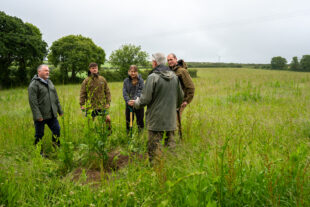https://defrafarming.blog.gov.uk/manage-weeds-in-grassland/
Manage weeds in grassland
The guidance on this page is for SFI pilot participants only. Please visit GOV.UK for the official Sustainable Farming Incentive scheme guidance.
Find out how land managers can keep permanent grassland in good condition and improve biodiversity by managing weeds.
If you’re completing this action as part of the Sustainable Farming Incentive pilot, how you do it is up to you.
The advice on this page can help you get better environmental and business benefits, but you do not have to follow it to get paid.
About weeds in grassland
Weeds can harm livestock, agricultural productivity and the environment, but native weeds like nettles are important for biodiversity. You should manage these weeds so that they can provide their benefits but do not spread and cause problems.
Harmful (‘injurious’) weeds are defined by law. These weeds are still important for biodiversity, but you must not allow them to spread onto neighbouring land.
Harmful weeds are:
- creeping thistle
- spear thistle
- common ragwort
- broad-leaved dock
- curled dock
Get specialist advice for invasive non-native species (INNS), because they need specific management. INNS are not likely to grow in well-managed grassland, but species like Himalayan balsam can develop on areas that are not grazed or cut, like field corners.
Benefits of managing weeds in grassland
When you manage weeds well, you’ll:
- improve yields
- improve hay quality
- protect your livestock’s health
- reduce or avoid herbicide use, which helps protect ground and surface waters
- meet your legal obligations to prevent the spread of harmful weeds
When you allow weeds to flower but stop them from spreading, you’ll:
- provide pollen, nectar and seeds for birds and invertebrates
- maintain the quality of species-rich grassland and high-value, low-input grassland
Before you start
Be aware that:
- a weed infestation may indicate underlying grassland management issues
- if you struggle to fix severe weed problems, you may need to get advice from an ecologist
- if you take areas like field corners out of production, you may need to act to stop the spread of weeds
Prevent bare ground
Bare ground will encourage too many weeds to grow. To prevent livestock creating bare ground, do not allow them to overgraze the sward. This can happen if you:
- keep high stock numbers
- use inappropriate stock
- graze one area for too long
Do not allow livestock to trample or poach the ground. This can happen if livestock are regularly moved along the same routes, or when feeding and watering areas are not well sited or moved regularly. Wet weather will make these problems worse.
Avoid:
- letting vehicle tyres or tracks make ruts in the ground
- tipping spoil, muck, rubbish or waste material in fields
- burning or other activities that can kill the sward
Avoid nutrient enrichment
Nutrient enrichment can encourage too many weeds to grow and spread. Use a nutrient management plan to make sure you only apply nutrients when the sward needs it.
To avoid nutrient enrichment, do not:
- deposit spoil, ditch cleanings or large amounts of dung onto the land
- let nutrients transfer from yards and buildings onto surrounding land
How to manage weeds in grassland
You should manage weeds through good grazing, and with machinery or by hand. Limit herbicide use to spot spraying and weed wiping.
Take extra care if you have historic features on your land.
If your land is part of a Site of Special Scientific Interest (SSSI), you must check if you need consent to apply herbicides before you start.
Grazing
Make it harder for weeds to establish by using grazing to maintain a dense and competitive grass sward. This is suitable for:
Manage livestock during the summer to create a variety of sward heights.
To manage more established weeds, you can reduce livestock numbers or use rotational grazing in the spring and autumn. A tall, strong sward will help keep weeds like thistles and docks at low levels. Maintain a continual sward height of at least:
- 8cm to 10cm for cattle pastures
- 6cm to 8cm for sheep pastures
Manage livestock levels so that animals do not create too much bare ground.
Cattle are prone to ragwort poisoning. Sheep are less prone to poisoning, but ragwort toxins will build up in the sheep’s livers and eventually make them ill. You can control ragwort using sheep but do not use the same animals year after year.
Topping
Topping is when you cut grassland with a mechanical topper attached to a tractor or quad bike. It can prevent most weeds from spreading by making them less vigorous and competitive.
Birds, nests and eggs are protected by law. You must check the area for birds before topping. If you see signs of ground-nesting birds, delay topping until birds fledge.
You should:
- top dense areas of thistles, docks and nettles in mid summer, just before the buds open, to remove flower heads and upper leaves
- top again 1 month later to prevent flowering
- repeat for up to 3 years to weaken the weeds’ roots
- remove topped cuttings where possible to prevent nutrient enrichment and growing plants being smothered
Topping ragwort can encourage growth. Only top ragwort if there is an immediate risk of it seeding and spreading onto neighbouring land.
You should be careful reintroducing livestock after you top ragwort. Dead cuttings and regrowth are more palatable to livestock and can poison them, especially cattle and horses.
Avoid topping Himalayan balsam as you would have to cut it low in mid summer and this would affect other flowering plants and invertebrates.
Pulling
When pulling, remove the entire root of the plant from the ground. You can use your hands or mechanical pullers attached to tractors or quad bikes.
You should pull common ragwort before it begins to seed. If you use a puller, the ragwort needs to be taller than the surrounding plants or grasses. It’s difficult to pull ragwort when the ground is dry. If you break the stem at ground level and do not remove the root, the plant will regrow strongly.
You should be careful reintroducing livestock after you pull ragwort. Dead plants and regrowth are more palatable to livestock and can poison them, especially cattle and horses.
You can pull Himalayan balsam easily because it is a shallow-rooted annual. Do not snap the stem or the plant will regrow. Pull Himalayan balsam in July, before it flowers. Pull it again in August or September to catch late-flowering plants.
Digging
You can dig out roots by hand, but it takes longer so it’s best for small areas of weeds. You can use specialist digging tools to remove the entire root. Dig weeds in the winter when the leaves are visible and you will not damage the surrounding sward.
Digging works well with docks and spear thistle. It also works for common ragwort in its first year of growth.
Herbicides
Herbicides control weeds but they can also kill other plants and pollute surface waters and groundwater. Only use herbicides when other weed control options are not possible or have not worked. Avoid using herbicides near water and on field corners.
Try to only use precision application methods, such as spot spraying and weed wiping. Weed wipers can work well if used correctly by an experienced operator.
What grassland managed well for weeds looks like
The cover of harmful weeds and nettles will be below 5%. Make sure that:
- no more than 5% of the field has dense patches of weeds dominating the sward
- when added together, the total scattered covering of weeds is less than 5% of the field
You’ll also see that:
- weeds do not spread to neighbouring land
- you can graze or cut hay with little risk of harm to livestock
- native weeds are not completely removed
- no invasive non-native species are growing



